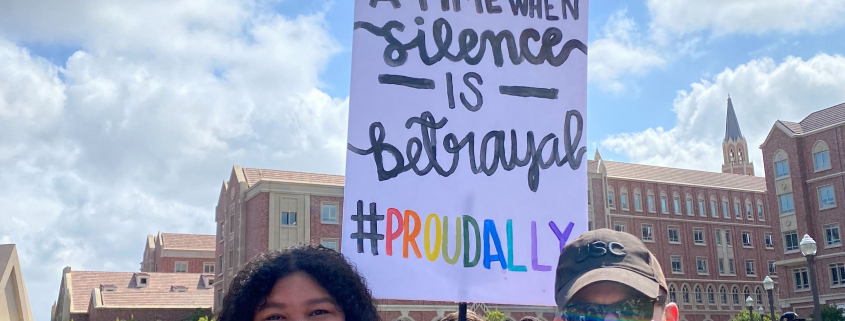The difference between a helpful and harmful ally

Lauren Mattice | Daily Trojan
With the recent outrage caused by the killings of Ahmaud Arbery, Breonna Taylor and George Floyd (among countless others), there has been a palpable shift in the United States: These deaths served as the final straw, igniting a revolution against the police brutality and systemic racism that reflects the country’s very foundations. According to USA Today, there are at least 700 cities actively protesting and these demonstrations have flooded the streets in all 50 states.
The Black Lives Matter movement has taken on new mediums, combining in-person activism with social media. The Black community has also called out to all non-Black people to step up as allies during this time — one-liners such as “White silence is violence” have decorated protesters’ posters en masse.
The Black community needs allies committed to the fight for justice; however, as an ally, there is a line to toe between effective and performative allyship … yes, there is such a thing as being a “bad” or “harmful” ally.
“[Denver School Board Director] Tay Anderson made a good point that has stuck with me: A lot of the violence and vandalism we’ve seen is being done by non-Black people,” Black Colorado activist Jayah Caley said. “It’s counterproductive to our movement.”
Navigating the Black Lives Matter movement while being non-Black may be difficult, but one of the best ways to prevent unintentional harm is by educating oneself. From reading “How to Be an Antiracist” by Ibram Kendi and watching “13th” on Netflix to actively engaging in difficult conversations about race, there are limitless resources one can use to expand one’s knowledge on systematic oppression and racism.
“Keep educating yourself, keep asking questions and be willing to listen when you are being corrected,” Caley said. “Take what you’ve learned and share it.”
Caley is correct that one of the most important and beneficial things an ally can do is to listen when they are being corrected. Many non-Black activists are well versed in the workings of the Black Lives Matter movement and the nuances of white allyship — but despite this knowledge and their good intentions, allies must be prepared to accept accountability when they make mistakes. It is equally important that allies do not attempt to educate Black community members about their own oppression — this is the equivalent of a student trying to tell the professor how to teach their class.
When it comes to virtual activism, social media is being used as a platform for sharing resources, signing petitions, locating donation sites and inciting intellectual discourse. To that end, Black activists have set the example of what one should and should not share as a digital ally. Many Black activists have asked community members to stop sharing the traumatizing videos of the killings of Black people. Instead, allies ought to use their platform to inform their followers on petitions and organizations they can donate to.
Media silence has been seen as one of the most harmful behaviors an ally can engage in. Particularly as a white ally, it is one’s responsibility to leverage one’s privilege to play a role in bringing justice to those who are oppressed. Whether that comes in the form of sharing the link to bail funds or the directions to a Black Lives Matter event, sharing something — anything — is better than sharing nothing, and many Black community members have made it perfectly clear that the message media silence from a white person sends is complicity.
It is also important to discuss how to be a good ally while protesting and attending Black Lives Matter events. During these events, non-Black attendees should remember that they are guests, not hosts.
Many non-Black allies have made the mistake of making the event about them by leading the marches or chants and by trying to tell Black community members how to organize. The purpose of an ally is to uplift the Black community and to form human barriers between Black protesters and the police — the presence of allies is certainly important, but they should behave accordingly.
There have been “allies” that have taken advantage of the protests, whether by looting for the sake of destruction or attempting to take charge in a tone-deaf demonstration of performative allyship. These digressions can be actively harmful to the goal of the protests — for instance, the looting that occurred during many protests managed to shift the narrative away from Black Lives Matter to the protesters engaged in property destruction.
Given that the United States is undergoing a major cultural shift in which the Black community is at the forefront, it is the duty of allies to engage in verbal and physical action to elevate the voices of this community to the best of their abilities.
Allies ought to use this time to educate themselves, to use their platforms for digital activism with the goal of inciting change and to use their privileged non-Black bodies to protect Black people at protests. They ought not to stay silent, take control or strip the microphone from the Black community. Allies must be cognizant of their role and continue to fight alongside the Black community for justice.

